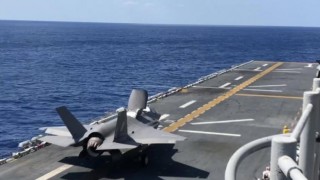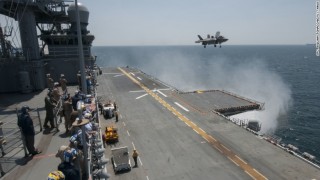Loading
Search
▼ Japan To Have First Aircraft Carriers Since World War II
- Category:Event
Tokyo (CNN)Japan is poised to put its first aircraft carriers to sea since World War II, refitting its Izumo-class warships to carry US-designed F-35B fighter jets, the government announced Tuesday.
In its 10-year Defense Program Guidelines, Tokyo said it will buy 42 of the stealthy F-35Bs, which are designed for short-run take offs and vertical landings.
Those planes will be available for deployment aboard two flat-top ships, the JS Izumo and JS Kaga, which at more than 800 feet long and displacing 27,000 tons are the largest ships in the Japanese fleet.
"Under the drastically changing security environment around Japan, the government will take all possible measures to protect the lives and assets of Japanese people," Chief Cabinet Secretary Yoshihide Suga said Tuesday in announcing the plan.
"The review of the new defense guideline is extremely meaningful to show the Japanese people and the world what is truly necessary in our defense to protect the people and to serve as the cornerstone of the future (for the Japan Self-Defense Forces)."
The new guidelines listed China, North Korea and Russia, as well as the United States and NATO, as entities with massive military capabilities with which Japan must concern itself.
Japan's Air Self-Defense Forces' new F-35A jet fighter arrives at Misawa Air Base on the northern end of the main island of Honshu in January.
The Izumo and Kaga have been carrying helicopters designed for anti-submarine warfare since entering service over the past three years. They will need to have their decks reinforced to accommodate the heavier F-35Bs, as well as the heat and force from the jets' thrusters when they land vertically.
Japan will also increase its order for F-35A jets, which take off and land on conventional runways, to 105, the government said. Forty-two of those jets are in service or were part of earlier Japanese orders. Those planes will replace the Japan Air Self-Defense Force's aging F-15J fighters.
The purchases will be spread over 10 years, with 27 of the F-35As and 18 of the F-35Bs to be acquired, as well as the two warships to be refitted, in the first five years.
Total spending over the first five years is pegged at $282.4 billion and will include creating cyber defense and naval transportation units that operate across Japan's three military branches, the Ground, Air and Maritime Self-Defense Forces.
An Eye on China
Carl Schuster, a former director of operations at the US Pacific Command's Joint Intelligence Center, said the new aircraft carriers would give Tokyo the ability to mount territory defenses farther out from its main islands.
Japan's JS Izumo steams with a US Navy destroyer in the South China Sea in 2017.
It comes after a Japanese defense white paper in August highlighted concerns about China. "China's rapid modernization of the People's Liberation Army, enhancement of operational capabilities, and unilateral escalation of activities in areas close to Japan are generating strong security concerns in the region and international community, including Japan," the paper said.
Analysts said Beijing would be forced to pay attention to the carrier capability.
"It further complicates the projection of Chinese military power into the southwestern maritime domain around Japan's Ryukyu islands," said Corey Wallace, an Asia security analyst at Freie University in Berlin.
However Wallace and Schuster both cautioned that the Japanese carriers are small and cannot carry many aircraft -- especially compared to the US Navy's massive 90,000-ton Nimitz-class carriers or even China's 58,000-ton Liaoning carrier.
When rumors of the Japan's carrier plans surfaced last month, China urged Tokyo to be cautious. An article in the state-run Global Times newspaper said the refit of the Izumo-class ships, and the purchase of the F-35Bs, "essentially changes the warships' nature from a defensive to offensive one."
"Japan must not forget its infamous history of invading countries and regions in the Asia-Pacific region during WWII," it added.
At the outset of World War II, Japan fielded one of the world's largest and best fleets of aircraft carriers. It was from those that the attack on Pearl Harbor was launched.
But the fleet was decimated in the war, and the post-war constitution put strict limits on Tokyo's forces that allows them to act only in a defensive role.
A Defensive Plan
In announcing the spending plan Tuesday, Japan stressed it is designed to buttress those defenses.The plan realizes the need to drastically strengthen Japan's defense and expand its role while the security environment around the country changes rapidly, the Defense Ministry said.
Choosing an expanded F-35 fleet enmeshes the Japanese Self-Defense Force with US and allied militaries around Asia, experts say.
The US, South Korea and Australia also are part of the F-35 program. The planes come with software suites which in theory allow them to communicate in real time in battle.
The US Marine Corps also operates F-35Bs off the US Navy's amphibious assault ships. Wallace said the future could conceivably see US F-35s operating from Japanese ships and/or Japanese F-35s flying off American ones.
Buying more F-35s also helps Japan curry favor with US President Donald Trump.
Trump has publicly touted international sales of the aircraft as a victory for his administration and praised foreign leaders who have purchased them.
The main assembly point for the F-35 is Fort Worth, Texas, but the jets are also put together in Nagoya, Japan, and Italy. Japanese government officials said all the planes in the new order will be imported.
CNN's Zachary Cohen contributed to this report.
- December 19, 2018
- Comment (0)
- Trackback(0)





